Okay, I can't stop playing this silly game. I had science victories in 210 turns as Korea and 194 turns as Rome. They were good, but I still feel room for improvement. The biggest omission in the Rome game was any midgame conquering to use up some surplus happiness. Or more generally, both games didn't really expand as far as I wanted, reaching 15 cities but not more. And the Rome game demonstrated again how enormous is the payoff from fast Desert Folklore into a speedy religion into a widely spread founder belief, an advantage that the Korea game hadn't had.
And despite what I recently wrote, I still want to give Liberty one more shot over Tradition. Liberty might still be better for expanding to maximum wideness, such that cities will never reach size 10 for the happy benefit from Aristocracy. Republic is a major component of that, coming in significantly stronger than I'd realized, and actually accounting for more than any single Tradition policy in the later game. Collective Rule is also good if the +50% comes fast enough before you start building any of your own settlers. The weak link is Citizenship, so skip that and go straight for the settler.
Putting this together, the fundamental point is that the determinant of your science rate is not so much the number of population, but the number of scientists. Building and staffing universities is the best conversion of hammers or any other input to beakers. Building a new city for a new university gets science more efficiently than anything else like building public schools or using the science pantheon. So that feeds back into another go as Korea with its specialist bonus. Go wide, using Republic to bootstrap baby cities, and support happiness with Meritocracy and Ceremonial Burial. (Not quite absolute max ICS though. The determining factor on whether to build a particular city is enough strength to build and staff a university before the end of the game.)
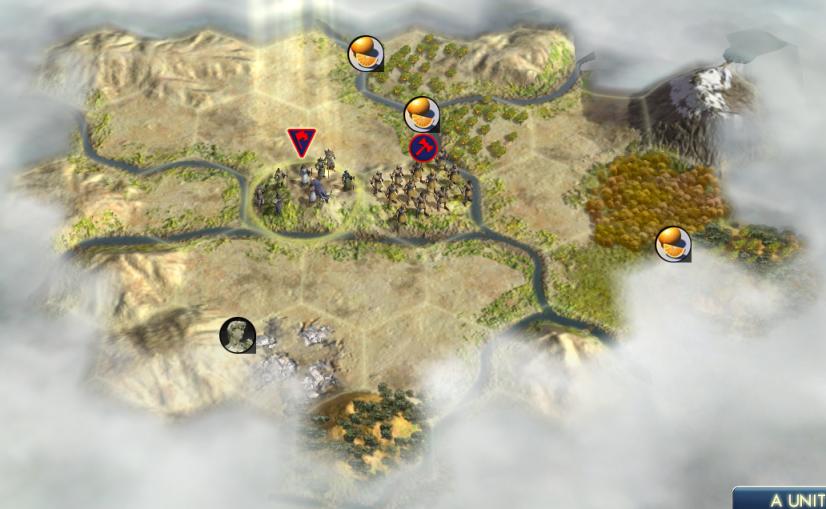
I shall call that sufficient desert, though it isn't monstrous with multiple wheat or anything. Since I was going Liberty not Tradition, I opened scout - monument, intending to buy the second scout at 140 gold.
Ancient ruins started slowly: nothing but Archery and barbarian camps within the first ten turns. Just as I was about to go reroll a new map:
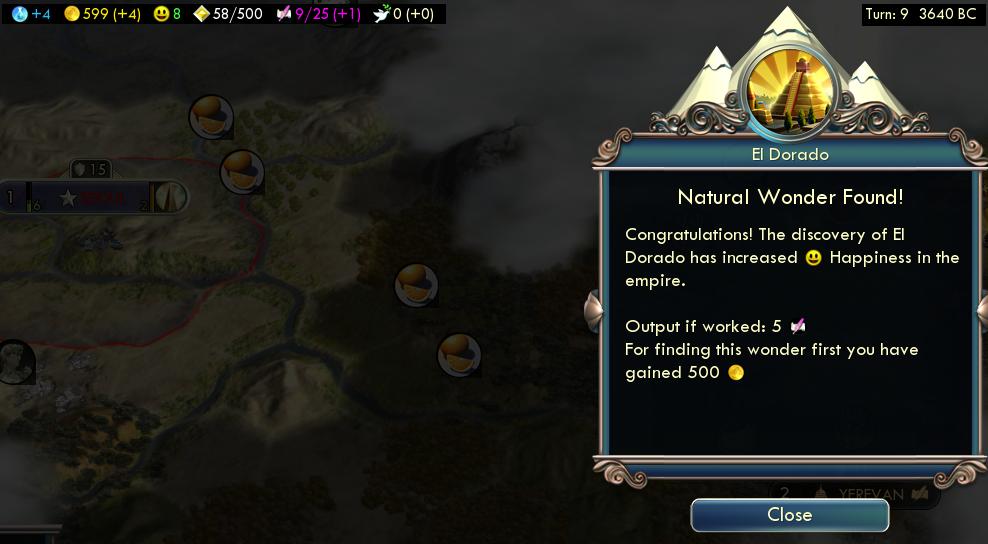
EL DORADO. Whoa baby.
They say a settler is the standard Skilldorado purchase, but I think that advice is dumb. A settler is not useful without worker followup. Instead, my shopping list read Scout immediately, Shrine as soon as Pottery came in, and then with a small AI loan a worker on turn 14.
The bought shrine and one religious CS resulted in Desert Folklore on turn 18, even a few turns faster than any other method. Even six turns faster on the shrine and pantheon makes a difference. That gets to the religion six turns faster, which is an additional missionary, which starts pressure sooner and snowballs to three or four extra converted cities.
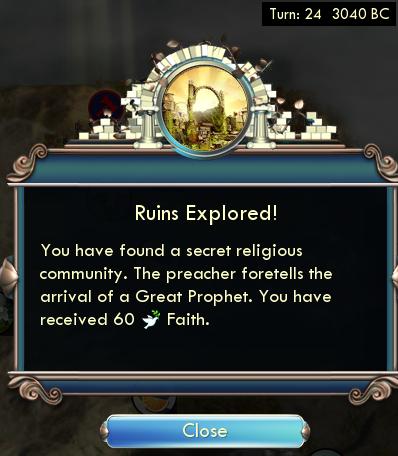
Or another ten turns faster. Mein gott, I better turn in a scintillating result here. It is true that for just about the first time ever, I'm playing out and reporting on a game that got no culture ruins pops. My early policies came on a normal schedule, powered only by a plain monument. So technically I'm satisfying that request that someone made, but on the whole I rather doubt this is really what that person meant. ![]() I did get one late ruin for survivors to size 5, but nothing else significant.
I did get one late ruin for survivors to size 5, but nothing else significant.
Build order was scout - monument - (bought scout, shrine, worker) - granary - archer - archer.
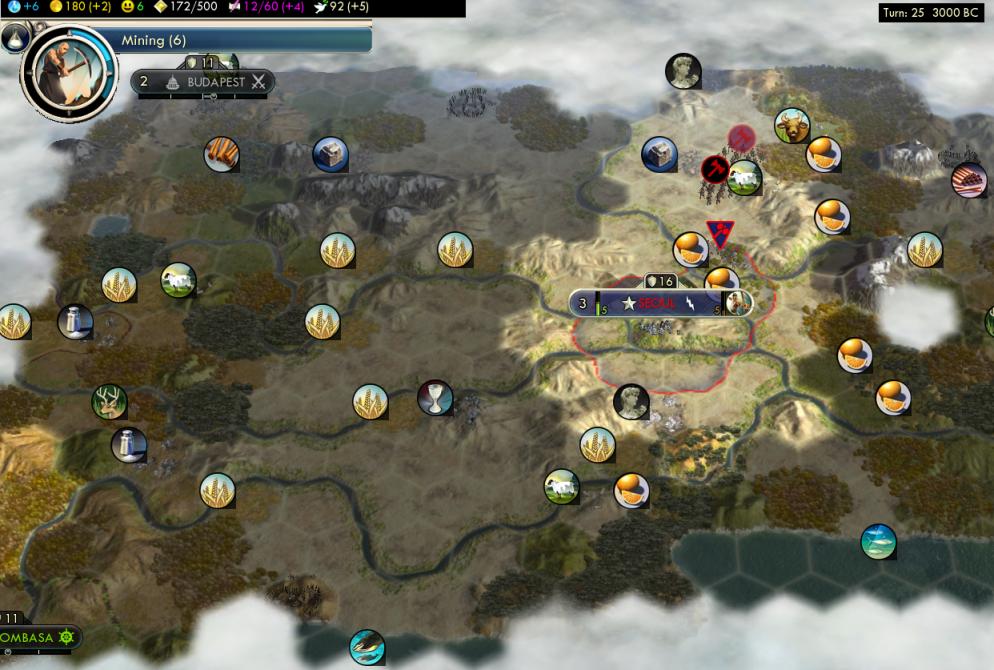
There's my neighborhood, got all the ingredients we need. Enough desert to get the Folklore well under way. Plenty of rivers. Six unique luxuries within range, though I'd have to be quick to get to the western salt and whales before my neighbor Askia. Seven sellable citrus, which now began as Calendar came in and the worker improved each of them, on turns 30 and 37. Each one turned immediately into a worker purchase. Collective Rule arrived on turn 37.
I love it when a build order looks like this: Settler - Settler - Settler - Settler - Settler - Settler. It was even correct to buy a bare hill tile for settler production: 65g for +1.5 hammers per turn over an unemployed citizen (with no other hammer tiles available) paid back very quickly.
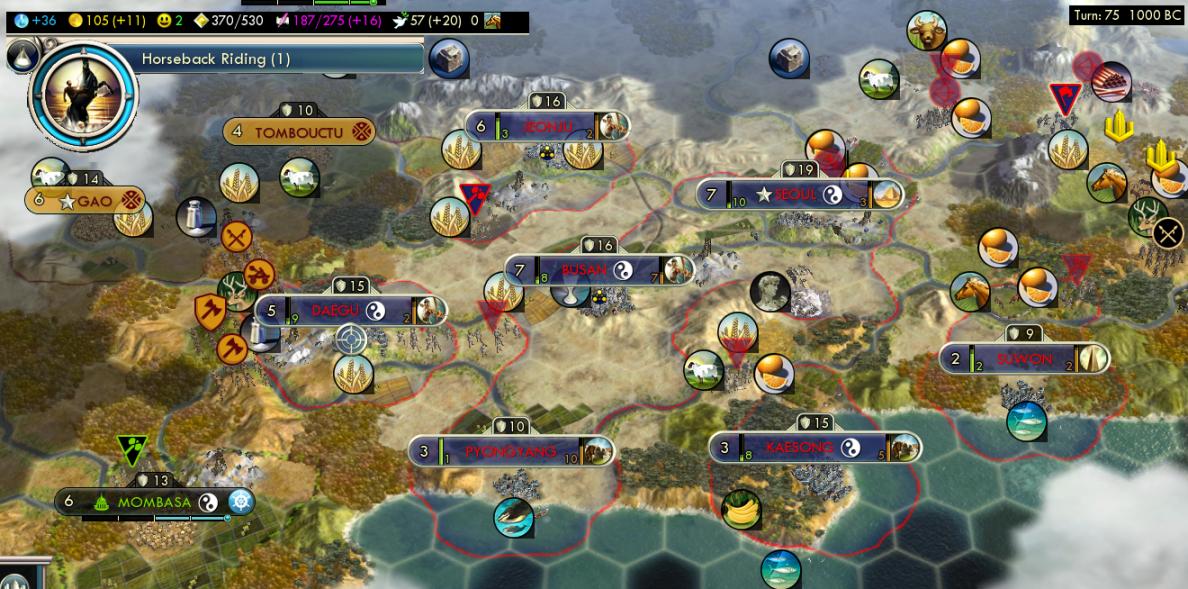
Like that, eight cities produced and planted in the next 25 turns, by 1000 BC. 33 population at this date, which blows away my previous mark of 23. That is how to correctly use Liberty: Skip weaksauce Citizenship. Go straight for the settler and then many more settlers, which line of play also synergizes with Republic. Buy workers.
 Of course, that only works if happy is coming from somewhere. My religion is already out to five cities, plus I got lucky on scouting natural wonders. And of course lots of resources. Only five of those resources are my own; two were simply bought from AIs with cash, and one is from a CS alliance from some quest. I often get asked how to handle happy in the early game. The answer is All Of The Above, get it any way you can -- except building colosseums. 100 hammers is too precious, that needs to go into granaries and monuments and workers instead.
Of course, that only works if happy is coming from somewhere. My religion is already out to five cities, plus I got lucky on scouting natural wonders. And of course lots of resources. Only five of those resources are my own; two were simply bought from AIs with cash, and one is from a CS alliance from some quest. I often get asked how to handle happy in the early game. The answer is All Of The Above, get it any way you can -- except building colosseums. 100 hammers is too precious, that needs to go into granaries and monuments and workers instead.
The picture above also shows where Askia just declared war. I easily saw this coming from twelve parsecs away, as soon as I settled Daegu. This was no threat thanks to those archers already in production. Especially given how Askia stupidly went and sent half his army at Mombasa instead of me, since of course the AI doesn't care about who he actually declared war on and blindly goes for the closest target.
Except it wasn't stupid - he actually captured Mombasa. Well, I built a total of six archers, timing Construction research just after to upgrade to comp bows. I recaptured Mombasa, and liberated it, it was definitely worth more as a maritime ally than under my own control. That was enough damage to induce Askia into ceding Tombouctu for peace, which was a great outcome.
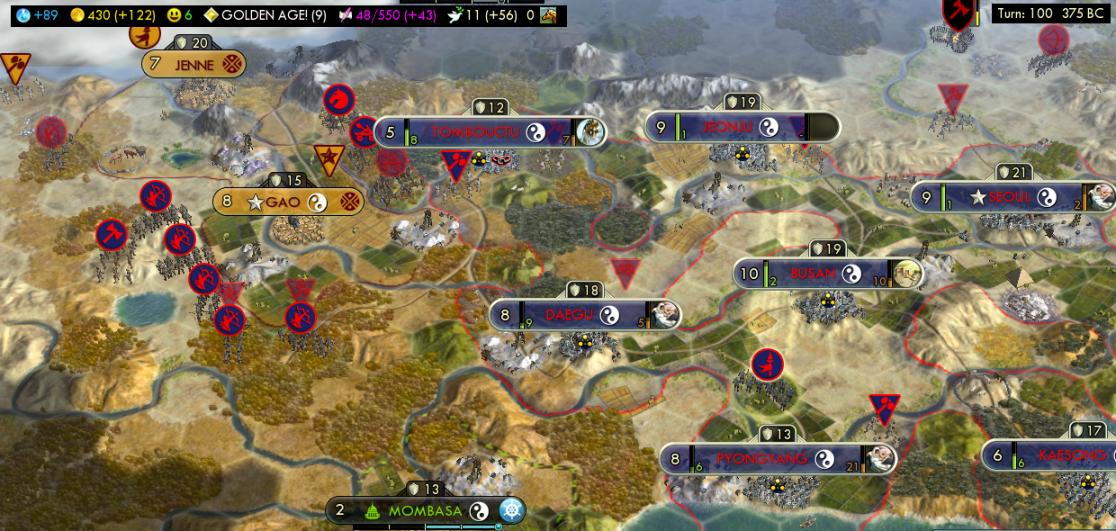
That war also touched off a highly amusing and lucrative chain-reaction of city-state quests. There was enough fighting to spawn me a Great General, which itself satisfied two CS. One was mercantile and provided Jewelry, which triggered a third CS quest. Which provided Gems, which triggered yet a fourth CS quest, and two cities into WLTKD. All for free. (Pretty much everything you do in Civ 5 is positive sum, even accidentally. I enjoy this stuff, but I sure do see where that design rubs some folks the wrong way.)
The Golden Age there is from Representation, as Liberty presently finished on this schedule.
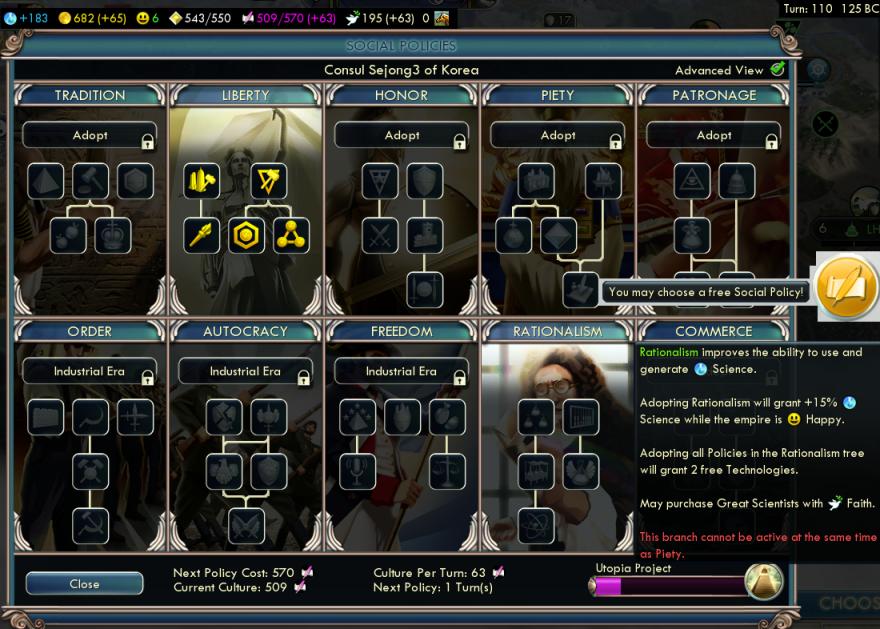
Here's the last reason that Liberty might actually beat Tradition after all for science. It completes slower, turn 99 here as compared to early 80s typical for Tradition. This is GOOD. Because then Rationalism can come in time for the 7th policy instead of having to burn one on the Patronage opener or some other weaksauce. This took some gymnastics: buy Seoul's university for both the Korea research boost and to staff it immediately to reach Acoustics in time. I annexed Tombouctu to purposely raise my policy costs, and even sold some monuments to slow culture for a moment, but that last was overthinky overkill and unnecessary.
So in general, Renaissance ASAP really is the way to go for science. Delay Engineering, Guilds, Optics to get Acoustics instead. Machu Picchu, aqueducts, and lighthouses can all wait, universities are more important anyway. Getting the Oracle into a Rationalism policy is also a required move for the fastest times.
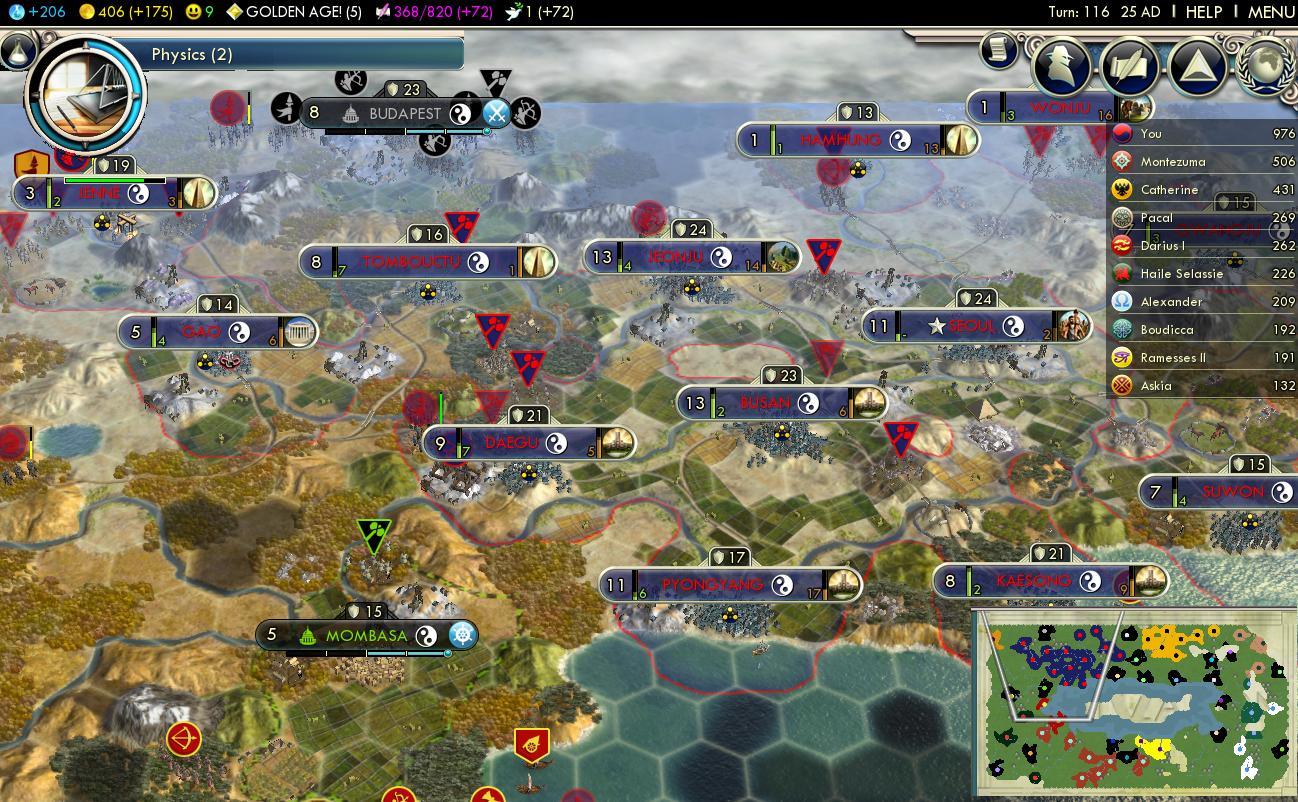
After the 10-turn peace treaty, I reopened hostilities on Songhai. They say that six composite bows is the best most efficient way to go conquering, and since I already had them, gotta go use them. I did add a couple catapults, which easily took the two remaining Songhai cities and left him with one up in the top corner. Besides the Songhai cities themselves, this move opened up to me that whole big western frontier of empty space. Now I could really push my city count where I wanted, more in a bit.
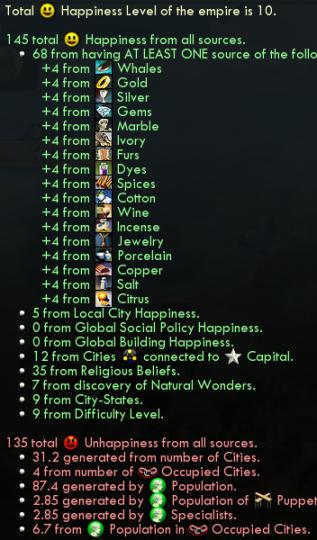
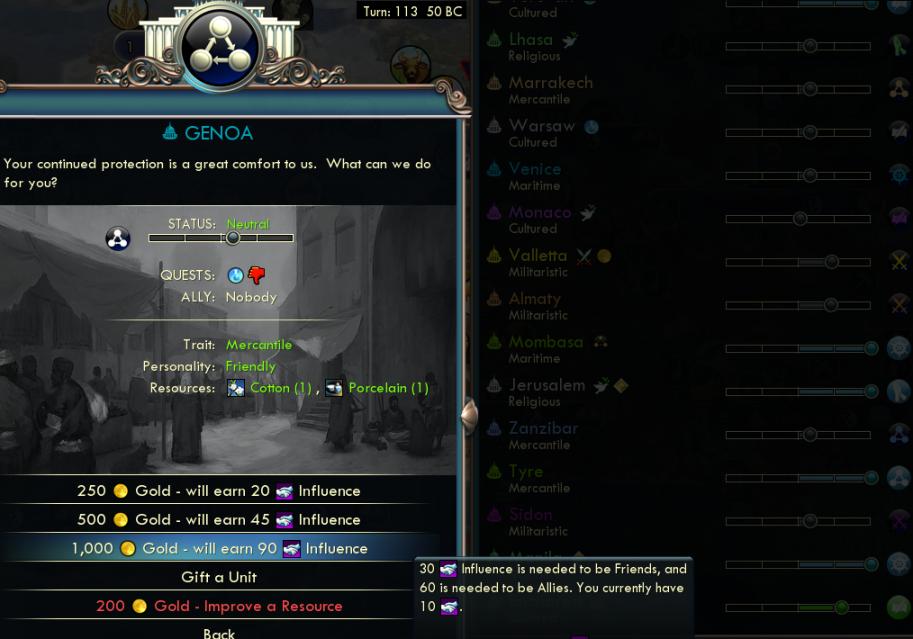
Here's the happy crunch, and the current solutions. 35 from Ceremonial Burial, which is monstrously huge - that combo of Desert Folklore and Ceremonial Burial has exploded out to the equivalent of 1750 hammers worth of colosseums. And then sometimes you just have to buy city states. 1000 gold is stiff, but that's 11 happiness total for 40 turns, half the remaining game. Buying this happy with colosseums instead would cost 2750 gold rather than 1000. And the cotton spun into fulfilling one additional CS quest plus several WLTKD.
Comparing here (50 AD) to my Rome game, this game was in fact doing better. 210 beakers to Rome's 200, and also moderate leads in faith and culture. But most importantly 103 population to Rome's 83.
Over in the religion department, I took a couple missionaries and then the enhancement Prophet as usual. The founder belief had been Ceremonial Burial of course. The enhancer was Religious Texts as always. First follower belief was Religious Community and the second Guruship, about which I'll say more in a moment.

This would appear to tell me that the leading AI civ produces no more than 8 faith per turn (23 over 3 turns), compared to my 65 per turn. However, unusually, all five possible AI religions were founded pretty early, by about 500 BC. This was important because it told me which AI civs would remain without their own religions and receptive to mine. Looking at that minimap, my most fertile target (already completed) was yellow Russia right next door to the east. The other religionless targets were Ethiopia (dark green) in the southwest, and Greece (white) in the opposite corner. Greece however was logistically difficult enough that I instead mostly sent missionaries to the city-states in the northeast and southwest, and later some to Aztecs (red) and Maya (brown) even against the resistance from their own religions.
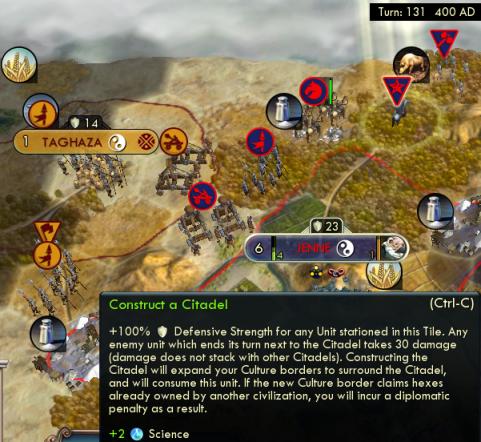
I'm never sure whether it's worth sharing side little moments like this, whether it adds to the texture of the writing or distracts from the report when it doesn't have anything to do with the overall thrust such as science. But here you go. I was proud of this move, burning my Great General to grab that ridiculously awkwardly located source of truffles, along with the extra salt too.
I decided the middle game research target would be Fertilizer, not Scientific Method as in my previous science games. With new cities still being founded, the passive mine and farm boosts were more important than public schools that nobody had the muscle to build yet anyway. Fertilizer hit in 425 AD for entry to the industrial age, an important milestone because it enables saving faith for Great Scientists instead of being forced into more missionary purchases.
For Research Agreements, I learned a lesson from my last Korea game that there isn't enough time for three waves between Education and game end. So instead I waited a bit, until turn 115, which would cycle two waves by turn 175, about when I hoped to complete the tech tree. I had three RAs per wave, with Greece, Ethiopia, and Alexander. The first wave matured on turn 145 for 4000 beakers total (you actually can't know how many per each individual RAs when they complete on the same turn), accounting for Metallurgy and Rifling.
Here's 500 AD, and we'll take an overview now, since I expanded out to my fullest reach now. (I know Strategic View isn't so pretty, but the camera zooms out farther there to show the entire empire at once. Regular view can't even fit Seoul and the left edge of the map on screen together.)
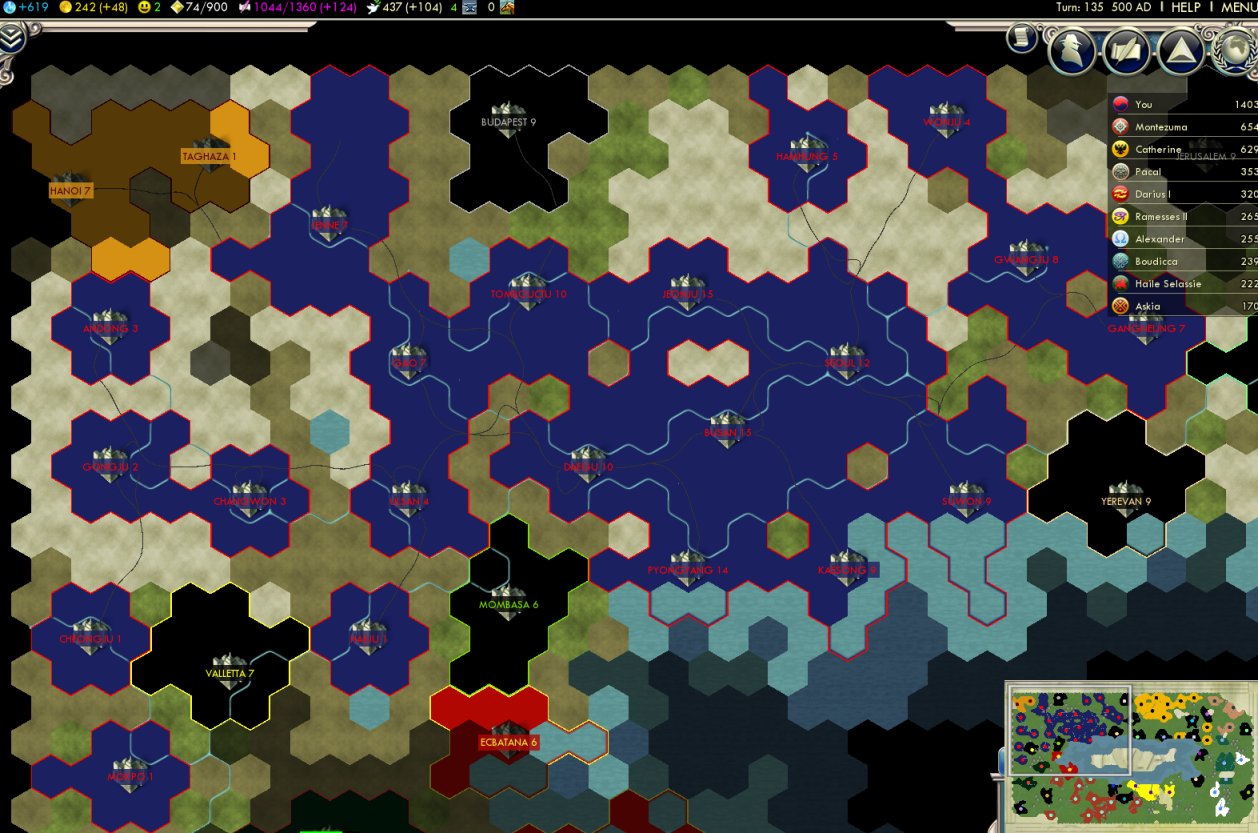
21 cities. What I still felt my previous Korea and Rome science games didn't get right was the city count, each reaching only 15 with some getting started pretty late. Now here I have 21 cities by 500 AD. And a good plan to get them developed leveraging Guruship.
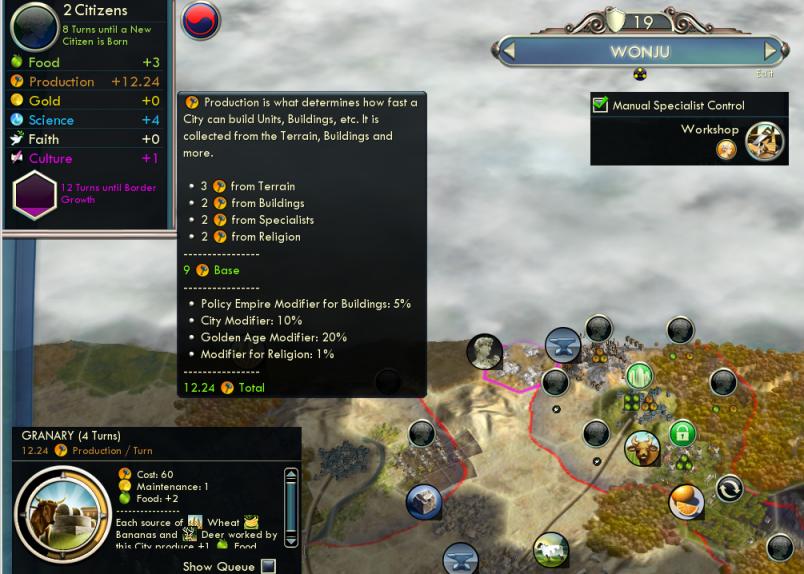
I now funneled my cash into WORKSHOPS for each of the new cities. That's +7 hammers in all. Two from the workshop itself, two from the engineer, two from Guruship, and the +10% for one more. This went a long long way towards getting cities off the ground quickly, building the basic granary and monument in about five turns each instead of the typical 20+ that occurs without this help. And even adds the 4 beakers from Korea's UA and Secularism.
The build order for virtually all of these cities was granary, monument, library, university, amphitheater, public school. Staff all the specialist slots, workshop and university and amphitheater. More on this in a bit.
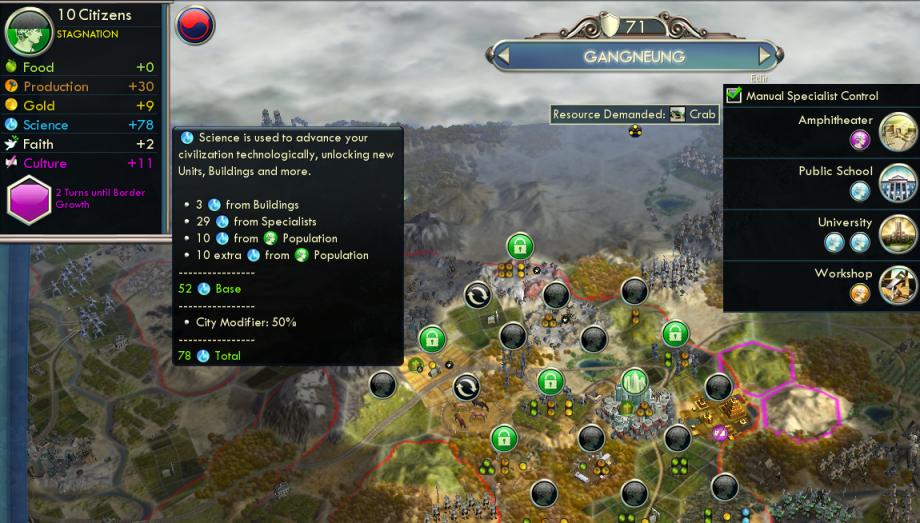
And here's what these cities looked like later on. Don't bother trying to grow much beyond size 10, and in fact most later cities stopped around 8. Staffing the specialists was more important. Food invested in growth couldn't produce enough later beakers to beat specialist beakers now. But this fairly modest city is up to a very solid 78 beakers. That's how to do fast science.
Rationalism came in on this schedule:
Notable in there is sparing one policy for the Order opener. That's thanks to Liberty and something Tradition wouldn't have allowed. The other thing Liberty does in the later game is Representation's discount. At 20 non-capital cities, that reduces culture policy cost from 400% of base to 300%, a very significant savings. That pretty literally means I get four policies in the space where three used to be. Besides the happy, Order is also very welcome for faith spending on Great Engineers, of which I'd use two later for the Statue of Liberty and Hubble Telescope.
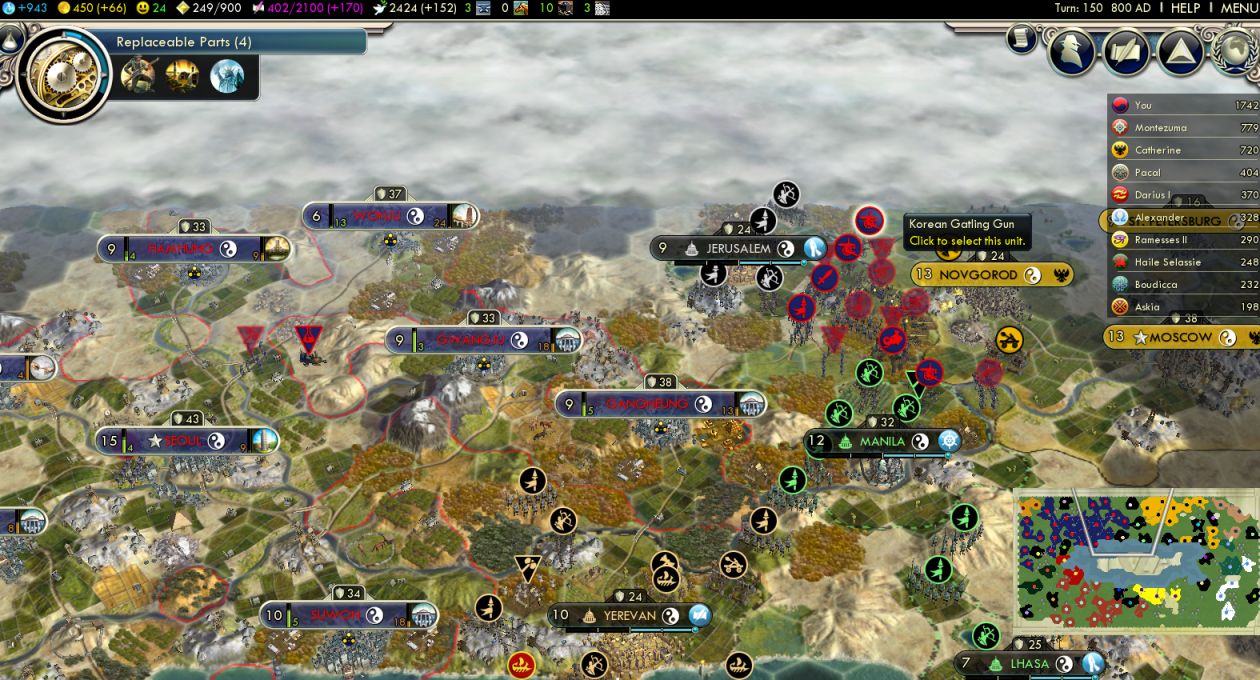
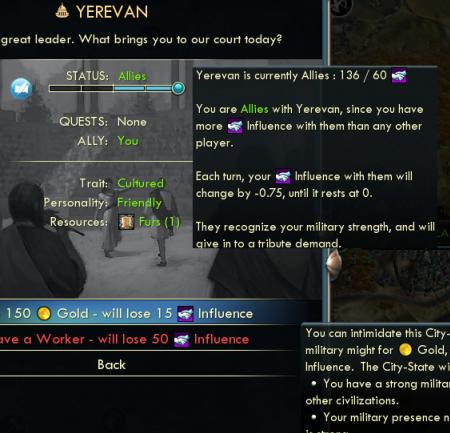
Time for my 800 AD checkin.
| Korea | Rome | Korea 2 | |
| Beakers | 683 | 632 | 943 (wow!) |
| Gold | 119 | 168 | 66 |
| Culture | 72 | 141 | 170 |
| Policies | 10.0 | 10.5 | 11.2 |
| Population | 128 | 140 | 198 |
| Researching | Electricity | Radio | Rep Parts |
| Crops | 404 | 386 | 635 |
| MFG | 280 | 273 | 383 |
Now that's a serious wide civilization done right. Nearly 50% more beakers than the previous attempts that I thought were good.
And it's going to get wider, yes I'm about to attack Russia right there. Something the Rome game didn't do right was add some conquered provinces with the midgame happy bubble from Notre Dame and Forbidden Palace. And this game added Order too for even more headroom. Idle happy is useless - to turn happy into science, you need more cities.
I put about 1000 gold into unit upgrades, modernizing my motley collection from early wars and militaristic CSes. Two catapults to cannons, three crossbows to gatling guns, two pikemen to rifles.
I even threatened a couple city-states for cash. Already got enough influence to last the entire game, and no pending quests, so why not?
The conquest of Russia went easily enough, not even worth any pictures. I conquered three Russian cities including Moscow and accepted two more for peace, which in all brought my surplus happy right about down to zero again, right where you want it. They weren't really very helpful though. I only annexed two Russian cities, since they were only useful with purchased courthouses and universities. This effort probably shaved one or maybe two turns from the finish date; arguable as to whether that was worthwhile.
(Speaking of money and bad AI behavior: I never realized this before, but when there's less than 22 turns remaining in the game, it becomes strictly correct to pay the AIs gpt for their entire treasury every turn. Another silly mechanic.)
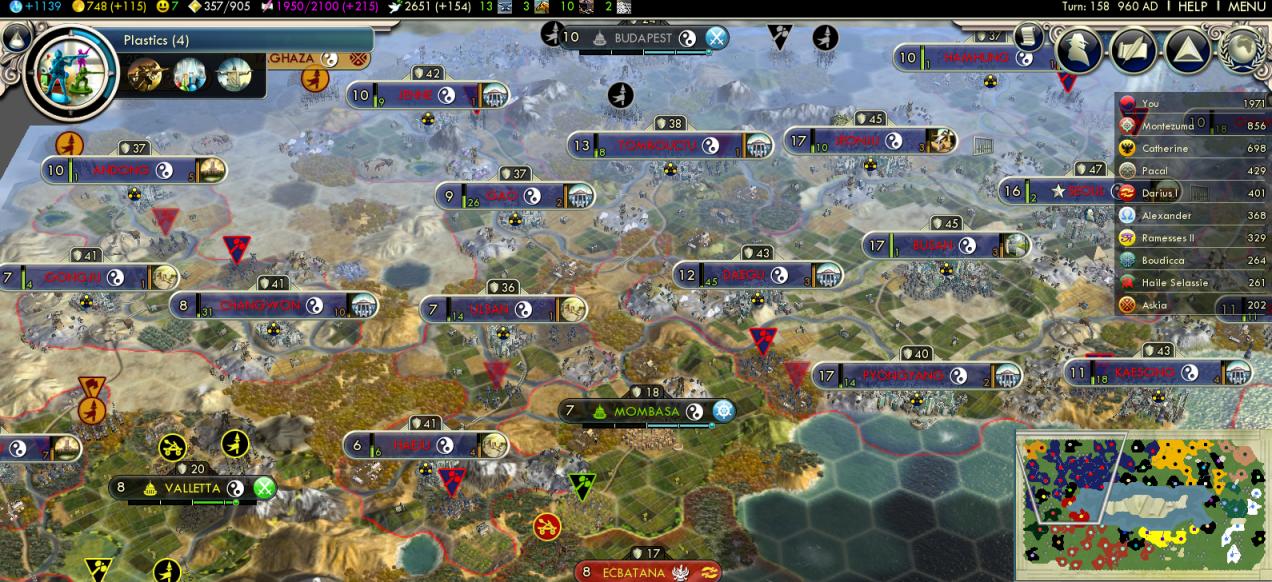
I realized this a bit later than I should have: In small cities, Public Schools are not the right build for science after universities! Amphitheaters are better, believe it or not. In a size 6 city, the PS is 300 hammers for 13 base beakers (3 from the building, 3 extra from population, plus the scientist slot for 7.) The amphitheater is 100 hammers for 4 beakers with an artist, only slightly worse -- but produces more science before endgame because it gets started fifteen turns sooner. And the amphitheater gives culture.
Workshops too, even, in cities that didn't already get them bought. They'd be just as beaker/hammer efficient as the amphitheater, after a few turns of the workshop and engineer paying back for the 20 hammer difference. I keep learning all over again that wide is good in Civ 5, in large part because more copies of low-end buildings are so much more attractive and efficient than the higher end.
So Public Schools really aren't very good. Heck, they're less science than universities straight-up, never mind per hammer efficiency. The real reason to build Public Schools is to get beyond them to the Research Labs, which are much better, adding 50 beakers even in a small city. Problem is, there isn't enough game left to actually build the Labs. I could buy a few labs in mature cities that had built the schools, but mostly we ended up going without any science buildings more advanced than universities and a few observatories.
So all this meant a smooth ramp of science. Amphis and workshops and a few PSes gradually kept completing for more science. There were no stark breakpoints to start bulbing. "8 turns after research labs" implies that you actually built research labs and in turn public schools.
So when was the right time to bulb? The answer was to start backtracking from the end of the game. I could expect 8 bulbs from the following eight scientists: two naturally produced, Pisa Tower, Porcelain Tower, two from Hubble, two from faith purchases. So that's 64 turns of research in my pocket. But you can't save all this for the end of the game, because each bulb discovers only one tech then stacks up as overflow.

Turn 158 had Radio reached, with 28 techs remaining. The obstacle now was the ability to burn all the overflow from bulbs into actual techs. From this point on, I attempted to make sure every end-of-turn converted lightbulb overflow into an actual tech. And got it just about right. The priority order was Rocketry for Apollo, then Nuclear Fission in order to open up last-column expensive techs for the Rationalism finisher (Satellites) and otherwise the order didn't matter. The two slack turns listed here actually weren't a hindrance - bulbing later wouldn't have been correct because then Apollo would have come later.
With science flawlessly optimized, I found myself production bottlenecked. Seoul was busy on a 915-hammer Oxford, so I had to have side cities do important stuff in Taj Mahal, Porcelain Tower, and Apollo Program. So my cash went into rushing factories and power plants for them rather than more science. (I dearly wished for enough culture to add Order's Planned Economy for half factory cost and +25% science, but it just wasn't there.) Fortunately I did have the Taj Mahal complete just right to have the Golden Age run through the part building. (Yeah, the Renaissance wonder completed in the Information Era, that's how fast science was sprinting.)
Even with that, the Apollo Program completed just one turn before the last tech. A micromanagement scramble ensued for part production, buying SS factories and hydro plants and solar plants. SS factories are first in that priority chain, the +50% is more yield than the power plants. For cash, I sold every single science and culture building in the cities, over several turns. I continued to threaten city-states for money and pay the AIs gpt for their entire treasuries. That added up to over 7000 gold spent on production buildings over the last five turns, carefully calculating which part-building cities needed the hammers sooner. Seoul as the strongest hammer city waited for the final part a turn later at Nanotechnology. I had a near-disaster in running out of aluminum for the last SS factory needed, and solved that by selling Seoul's hydro plant just to recover the aluminum.
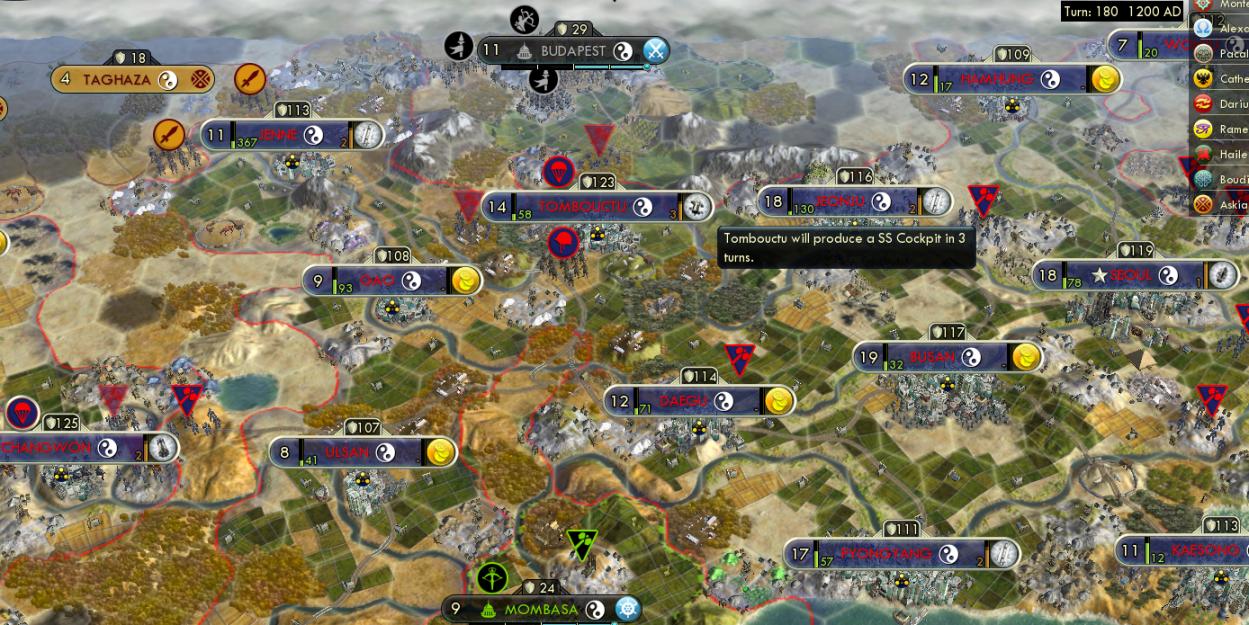
There's the six parts; Tombouctu will shave that turn by getting a lumbermill and a forest chop on the last turn. In the end, I had all six completed five turns after the last tech. That was three turns slower than the Rome game which managed it with only two turns of production overtime, but good enough.
Well, add one more turn after I realized in horror that three of the parts would need an extra turn of railroad movement to reach Seoul. ![]() (How dumb is that rule? Who cares about moving parts around?)
(How dumb is that rule? Who cares about moving parts around?)

Science Victory on Turn 183 1230 AD. Yeah, now I'm satisfied.

The graph of beaker production, showing the exponential curve that we all know and love in the Civ games, unlike the linear ramp that the Rome game exhibited. This game played the later eras correctly, conquering cities later and continuing to add more science multipliers the whole game. Ignore the drop at the end, that's after selling all the science buildings to buy factories.
I've said before that I'm closing the books on Civ 5 reporting, but I might still have one more game to share.